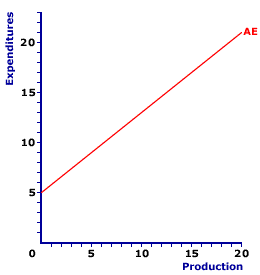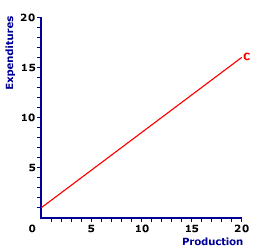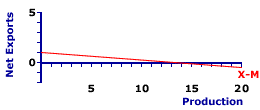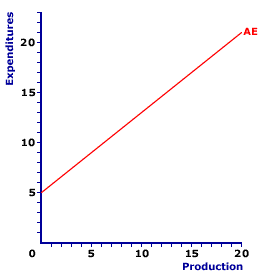
|
|
BANKING: The industry consisting of financial intermediaries that maintain deposits (that is, the industry of banks). Banking is one of several financial industries, with insurance and stock trading two other notable examples. Firms that comprise the banking industry are traditional banks, savings and loan associations, credit unions, and mutual savings banks. Banking in modern economies is generally fractional-reserve banking, with banks acting as financial intermediaries and safekeepers of deposits.
Visit the GLOSS*arama
|
|


|

|
                           AGGREGATE EXPENDITURES LINE: A graphical depiction of the relation between aggregate expenditures by the four macroeconomic sectors (household, business, government, and foreign) and the level of aggregate income or production. In Keynesian economics, the aggregate expenditures line is the essential component of the Keynesian cross analysis used to identify equilibrium income and production. Like any straight line, the aggregate expenditures line is characterized by vertical intercept, which indicates autonomous expenditures, and slope, which indicates induced expenditures. The aggregate expenditures line used in Keynesian economics is derived by adding or stacking investment, government purchases, and net exports to the consumption line. The aggregate expenditures line, which embodies the key Keynesian principle of effective demand, shows the relation between aggregate expenditures and the actual level of aggregate income or production in the domestic economy. The income and production measures commonly used are national income and gross domestic product.The purpose of the aggregate expenditures line is to graphically illustrate the basic expenditures-income relation for the economy, which is the foundation of the aggregate expenditures line used in Keynesian economics. The intersection of the aggregate expenditures line and the 45-degree line indicates the equilibrium level of income and production. The aggregate expenditures line comes in different varieties, depending on the specific Keynesian model under study, the number of sectors included in the analysis, and which expenditures are assumed autonomous and which are induced by income. The three most common aggregate expenditures lines are for a two-sector analysis (household and business), three-sector analysis (adding government), and four-sector analysis (adding the foreign sector). The two basic types of expenditures--autonomous and induced--are indicated by the aggregate expenditures line. - Autonomous expenditures are the vertical intercept, or Y-intercept, of the aggregate expenditures line. This is the sum of autonomous consumption, autonomous investment, autonomous government purchases, and autonomous net exports.
- Induced expenditures are the slope of the aggregate expenditures line. The marginal propensity to consume (MPC), which is the slope of the consumption line, forms the foundation of the slope of the aggregate expenditures line. This slope, however, is augmented by the marginal propensity to invest (MPI), marginal propensity for government purchases (MPG), and marginal propensity to import (MPM).
An Overview| Aggregate Expenditures Line | 
|
A representative aggregate expenditures line is presented in the exhibit to the right. This red line, labeled AE in the exhibit is positively sloped, indicating that greater levels of income and production generate greater aggregate expenditures by the four macroeconomic sectors. This positive relation reflects the Keynesian economics principle of effective demand--more income means more expenditures.The two primary characteristics of the aggregate expenditures line are slope and intercept: - Slope: The slope of the aggregate expenditures line presented here is positive, but less than one. In fact, the slope of the aggregate expenditures line is numerically equal to the marginal propensities for all expenditures included in the construction of this line. In this case the slope is equal to 0.8. The positive slope reflects induced expenditures--more income and production means more expenditures. This also reflects the basic Keynesian principle of effective demand. Click the [Slope] button to illustrate.
- Intercept: The aggregate expenditures line intersects the vertical axis at a value of $5 trillion. Theoretically, this is a minimum "baseline" level of aggregate expenditures, the amount of expenditures undertaken by the four sectors even if income and production fall to zero. More to the point, this intersection indicates autonomous expenditures--aggregate expenditures unrelated to income. Click the [Intercept] button to illustrate.
Before leaving this aggregate expenditures line note that the level of income and production generated by full employment of resources is NOT indicated in this exhibit. Full employment could correspond with $2 trillion of income or $20 trillion. There is no way of knowing. This is particularly important when the equilibrium level of production is identified. The resulting equilibrium may or may not correspond with full employment.Four ExpendituresThe aggregate expenditures line is the combination of expenditures by the four macroeconomic sectors--household, business, government, and foreign. Each of these four sectors is responsible for a specific expenditure on gross domestic product--consumption, investment, government purchases, and net exports. And each expenditure is represented by a corresponding expenditure line.| Consumption Line |  | Investment Line |  | Government Purchases Line |  | Net Exports Line |  |
The exhibit to the right presents the linear relations for each of the four aggregate expenditures.- Consumption Expenditures: The largest of the four expenditures on gross domestic product is consumption expenditures by the household sector. These expenditures are used to purchase everything from apple juice to cubic zirconium, essentially all of the goods and services that people purchase to satisfy wants and needs. The consumption line is the relation between these consumption expenditures and aggregate income or production. A representative consumption line, labeled C, is presented in the top panel of the exhibit to the right. This red line is positively sloped due to the Keynesian psychological law and the slope is measured by the marginal propensity to consume (MPC). The intercept is autonomous consumption.
- Investment Expenditures: The least stable of the four expenditures on gross domestic product is investment expenditures by the business sector. These are expenditures on capital goods, ranging from million-dollar factories to fifty-cent screw drivers. Investment expenditures are for fixed structures, equipment, and inventories (working capital). The relation between investment expenditures and aggregate income or production is illustrated by an investment line. Two alternative investment lines are presented in the second panel of the exhibit to the right. The horizontal gray line, labeled I, indicates autonomous investment, investment that is unaffected by income or production. The positively-sloped red line, labeled I', is induced investment, investment that is affected by income or production, and is measured by the marginal propensity to invest (MPI).
- Government Purchases: A key fiscal policy tool used to stabilize business cycles is government purchases on gross domestic product by the government sector. These are expenditures on goods and services used for a wide range of government activities, ranging from military aircraft to paper clips, and includes expenditures by federal, state, and local governments. It includes both capital goods as well as consumption goods. The relation between government purchases and aggregate income or production is illustrated by a government purchases line. Two alternative government purchases lines are presented in the third panel of the exhibit to the right. The horizontal gray line, labeled G, indicates autonomous government purchases, government purchases that are unaffected by income or production. The positively-sloped red line, labeled G', is induced government purchases, government purchases that are affected by income or production, and is measured by the marginal propensity for government purchases (MPG).
- Net Exports: The smallest of the four expenditures on gross domestic product are net exports by the foreign sector. Net exports are the difference between exports, domestic production purchased by the foreign sector, and imports, foreign production purchased by the three domestic sectors (household, business, and government). The relation between net exports and aggregate income or production is illustrated by the net exports line. A typical net exports lines is show in the bottom panel of the exhibit to the right. This negatively-sloped red line, labeled X-M, is the combination of autonomous exports and induced imports. Because imports are subtracted from exports, the negative slope of the net exports line is the negative of the marginal propensity to import (MPM).
Three LinesThe aggregate expenditures line actually comes in several varieties, depending on how many of the four expenditures are included and whether or not the expenditures are assumed to be induced or autonomous. The three most common aggregate expenditures lines represent the sequential inclusion of the four expenditures, beginning with consumption expenditures and investment expenditures, then adding government purchases and net exports.- Two Sectors: The simplest aggregate expenditures line is based on expenditures by the two "private" sectors--household and business. This two-sector aggregate expenditures line is the combination of consumption expenditures and investment expenditures. More often than not, this line is based on autonomous investment. This two-sector line captures the essential elements of Keynesian economics and thus is often used as an introductory presentation. One important element captured in this line is, first and foremost, induced consumption and the psychological law. Another element is the equilibrium equality between production and expenditures and the potential instability created by changes in autonomous investment.
- Three Sectors: A second expenditures line is obtained by adding the "public" or government sector to the two-sector line. This three-sector aggregate expenditures line is the combination of consumption expenditures, investment expenditures, and government purchases. In addition, an adjustment of consumption expenditures for taxes is also commonly incorporated in this line. This expanded line is not only more realistic, it also enables the analysis of the impact of government fiscal policies on the economy, which is a key consideration of Keynesian economics. The three-sector aggregate expenditures may or may not include induced investment, induced government purchases, or induced taxes.
- Four Sectors: The complete expenditures line is constructed by adding net exports to the three-sector line. This four-sector aggregate expenditures line is the combination of consumption expenditures, investment expenditures, government purchases, and net exports. While the assorted expenditures can be assumed autonomous, as the "complete" aggregate expenditures line, anything that is realistically induced by income and production is generally assumed to be induced in the construction of this line.
Shocking The Line| Determinants | 
|
Whichever aggregate expenditures line that forms the basis of an analysis (two-, three-, or four-sectors), it is subject to disruption by the aggregate expenditures determinants. These determinants are any ceteris paribus factors, other than income or production, that affect one or more of the aggregate expenditures. A few of the more important determinants are interest rates, expectations, fiscal policy, and wealth.These determinants cause changes in autonomous expenditures and the vertical intercept of the aggregate expenditures and in so doing shift it up or down. The exhibit to the right can be used to illustrate the up and down shifts of the aggregate expenditures line. - Shifting Up: An increase in aggregate expenditures is illustrated by a vertical upward shift of the aggregate expenditures line. This can be demonstrated by clicking the [Up] button in the exhibit. Note that the vertical intercept, or autonomous expenditures, is greater. This increase can be caused by lower interest rates, expansionary fiscal policy, or optimistic expectations.
- Shifting Down: A decrease in aggregate expenditures is illustrated by a vertical downward shift of the aggregate expenditures line. This can be demonstrated by clicking the [Down] button in the exhibit. Note that the vertical intercept, or autonomous expenditures, is now less. This decrease can be caused by higher interest rates, contractionary fiscal policy, or pessimistic expectations.

Recommended Citation:AGGREGATE EXPENDITURES LINE, AmosWEB Encyclonomic WEB*pedia, http://www.AmosWEB.com, AmosWEB LLC, 2000-2025. [Accessed: July 5, 2025].
Check Out These Related Terms... | | | | | | | | | |
Or For A Little Background... | | | | | | | | | | | | | | | | | | | | |
And For Further Study... | | | | | | | | | | |
Search Again?
Back to the WEB*pedia
|



|

|
GREEN LOGIGUIN
[What's This?]
Today, you are likely to spend a great deal of time at an auction wanting to buy either a coffee cup commemorating the 1960 Presidential election or a how-to book on fixing your computer, with illustrations. Be on the lookout for telephone calls from former employers.
Your Complete Scope
This isn't me! What am I?
|

|
|
The word "fiscal" is derived from a Latin word meaning "moneybag."
|

|
|
"Plans are only good intentions unless they immediately degenerate into hard work." -- Peter Drucker, management consultant
|

|
ARIMA
Autoregressive Integrated Moving Average
|

|
|
Tell us what you think about AmosWEB. Like what you see? Have suggestions for improvements? Let us know. Click the User Feedback link.
User Feedback
|


|


